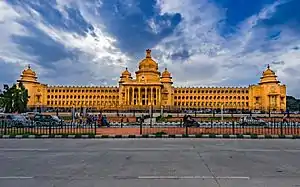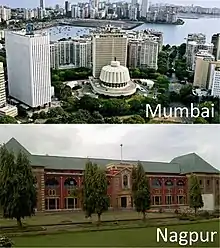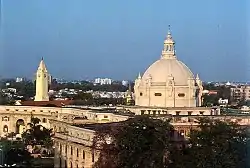State legislative councils of India
The State Legislative Council, or Vidhan Parishad, is the upper house in those 6 states of India that have a bicameral state legislature; the lower house being the State Legislative Assembly. Its establishment is defined in Article 168 of the Constitution of India.
 |
|---|
| This article is part of a series on the politics and government of India |
|
|
Template:As ofjan, 6 out of 29 states have a State Legislative Council. The latest state to have a council is Telangana.[1][2]
Qualification and Tenure
To become a member of a State Legislative Council (MLC), a person must be a citizen of India, at least 30 years old, mentally sound, not an insolvent, and must be enrolled on the voters' list of the state for which he or she is contesting an election. He or she may not be a Member of Parliament and Member of the State Legislative Assembly at the same time.
The tenure of the MLCs are six years. One-third of the members of State Legislative Council retire after every two years. This arrangement parallels that for the Rajya Sabha, the upper house of the Parliament of India.[1]
Composition
The size of the State Legislative Council cannot be more than one third of the membership of the State Legislative Assembly. However, its size cannot be less than 40 members. These members elect the Chairman and Deputy Chairman of the State Legislative Council.
MLCs are chosen in the following manner:[1]
- One third are elected by the members of local bodies such as municipalities, Gram panchayats, Panchayat samitis and district councils.
- One third are elected by the members of Legislative Assembly of the State from among the persons who are not members of the State Legislative Assembly.
- One sixth are nominated by the Governor from persons having knowledge or practical experience in fields such as literature, science, arts, the co-operative movement and social services.
- One twelfth are elected by persons who are graduates of three years' standing residing in that state.
- One twelfth are elected by teachers who had spent at least three years in teaching in educational institutions within the state not lower than secondary schools, including colleges and universities.
Role
The Constitution of India gives limited power to the State Legislative Council. The State Legislative Council can neither form or dissolve a state government. The State Legislative Council also have no role in the passing of money bills. But some of the powers it has is that the Chairman and Deputy Chairman of the State Legislative Council enjoy the same status of Cabinet Ministers in the state.[1]
List of State Legislative Councils
As of January 2020, 6 out of the 28 states have State Legislative Council [1]
| State Legislative Council (Vidhan Parishad) |
Image | List of constituencies | Seat/state capital | Number of constituencies | Ruling party | |||
|---|---|---|---|---|---|---|---|---|
| Elected | Nominated | Total | ||||||
| Andhra Pradesh Legislative Council |  |
List | Amaravati | 50 | 8 | 58 | YSR Congress Party | |
| Bihar Legislative Council |  |
List | Patna | 63 | 12 | 75 | Janata Dal (United) | |
| Karnataka Legislative Council |   |
List | 64 | 11 | 75 | Bharatiya Janata Party | ||
| Maharashtra Legislative Council |  |
List | 66 | 12 | 78 | Shiv Sena | ||
| Telangana Legislative Council |  |
List | Hyderabad | 34 | 6 | 40 | Telangana Rashtra Samithi | |
| Uttar Pradesh Legislative Council |  |
List | Lucknow | 90 | 10 | 100 | Bharatiya Janata Party | |
| Total | 367 | 59 | 426 | |||||
Creation and Abolition of State Legislative Council
According to the Article 169 of the Constitution of India, the Parliament of India can create or abolish the State Legislative Council of a state if that state's legislature passes a resolution for that with a special majority. Many Legislative Councils were abolished since Independence. For example, the West Bengal Legislative Council was abolished in 1969. Another example is that of Andhra Pradesh Legislative Council which was abolished in 1985, but was formed again in 2007.[1][3]
Abolished State Legislative Councils
The existence of a State Legislative Council has proven politically controversial. A number of states that have had their Legislative Council abolished have subsequently requested its re-establishment; conversely, proposals for the re-establishment of the Legislative Council for a state have also met with opposition. Proposals for abolition or re-establishment of a state's Legislative Council require confirmation by the Parliament of India.
| State Legislative Council (Vidhan Parishad) |
Seat/state capital | No. of seats | Year established | Year abolished | Notes |
|---|---|---|---|---|---|
| Assam Legislative Council | Shillong | 42 | 1935 | 1969 | Abolished by the Assam Legislative Council (Abolition) Act, 1969 |
| Bombay Legislative Council | Bombay | 1862 | 1960 | Abolished by the Bombay State Reorganisation Act, 1960 | |
| Jammu and Kashmir Legislative Council | 36 | 1957 | 2019 | Abolished by the Jammu and Kashmir Reorganisation Act, 2019. | |
| Madhya Pradesh Legislative Council | Bhopal | 1956 | 1969 | Abolished by the Madhya Pradesh Legislative Council (Abolition) Act, 1969 | |
| Punjab Legislative Council | Chandigarh | 39 | 1956 | 1969 | Abolished by the Punjab Legislative Council (Abolition) Act, 1969. |
| Tamil Nadu Legislative Council | Chennai | 78 | 1956 | 1986 | Abolished by the Tamil Nadu Legislative Council (Abolition) Act, 1986 |
| West Bengal Legislative Council | Kolkata | 98 | 1952 | 1969 | Abolished by the West Bengal Legislative Council (Abolition) Act, 1969 |
Criticism
The Legislative Councils are criticised for being unnecessary. It is considered a burden on the state budget and cause delays in passing legislations.[1]
See also
References
- "WHAT IS LEGISLATIVE COUNCIL". Business Standard. Retrieved 7 September 2020.
- GK Today
- PTI. "Trinamool to revive legislative council in WB". The Hindu.